Mirpur Katan saree gets GI recognition — But for whose gain?
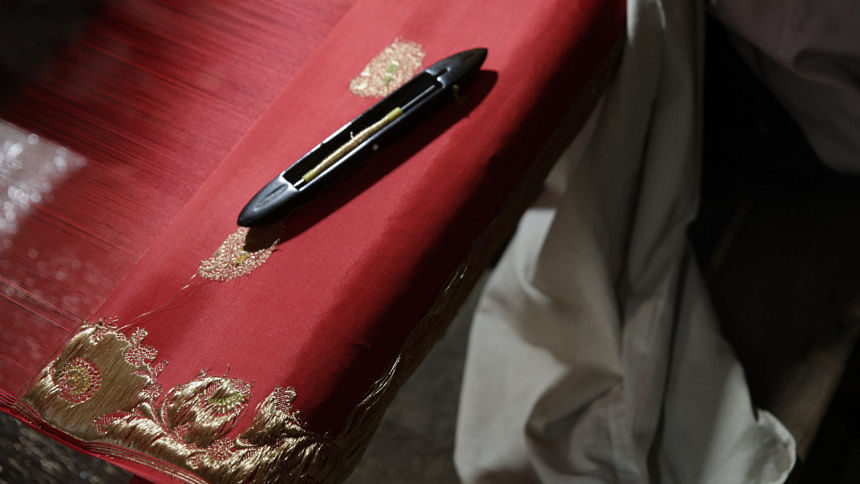
In the heart of Mirpur's Benarasi Polli, decades-old looms still clatter, but the promises of protection and prosperity have yet to reach the artisans. This story traces the threads of history, hope, and hardship, asking: 'When will recognition turn into real change?'
The air grew heavier as Md Rafiq led us through a narrow, crumbling alley into a dimly lit tin-shade house in Benarasi Polli. Two half-broken ceiling fans whirred above the heads of four weavers, who worked tirelessly in a room barely large enough to stretch their legs. Their feet pushed the treadles, hands tossed the shuttle, and the loom clattered on. It was the sound of survival, not celebration.
The Mirpur Katan saree, once referred to simply as 'Benarasi' by older generations, was recently granted Geographical Indication (GI) status. The recognition, at least in theory, protects its identity and promotes the preservation of local craftsmanship. But in the alleys of Mirpur, the excitement has not trickled down to the looms.
"We have heard of the recognition, but haven't received any practical benefits yet," answered 70-year-old Md Rafiq, former president of the Benarasi Primary Taant Samiti in Mirpur. His hands are weathered by decades of weaving, and his eyes quietly reflect the economic struggles he still endures.
"We used to call it Benarasi, now we call it Mirpur Katan. It's from here, made by us. But what has changed for us?" asked Rafiq, his voice equal parts pride and resignation.
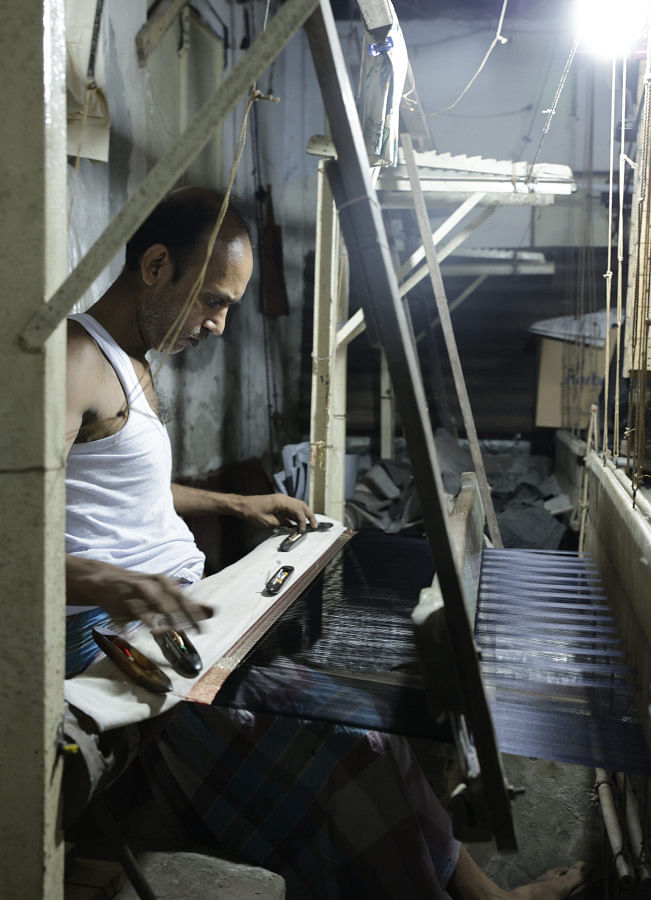
A name woven from migration
The roots of Mirpur Katan trace back to post-partition Dhaka, when master weavers migrated from Varanasi, India, bringing with them the secrets of Benarasi weaving. They eventually blended Indian patterns with local threads, creating a new textile language that is distinct, dignified, and dazzling. The silk was heavier, the motifs more detailed, and the finish unmistakably Mirpur.
But over the years, the "Benarasi" tag remained, confusing buyers and conflating regional identities. The GI status should have cleared the air. It should have allowed the artisans to brand their work confidently and demand fair pricing. What it has done instead is serve as another layer of prestige with no clear distribution of benefits.
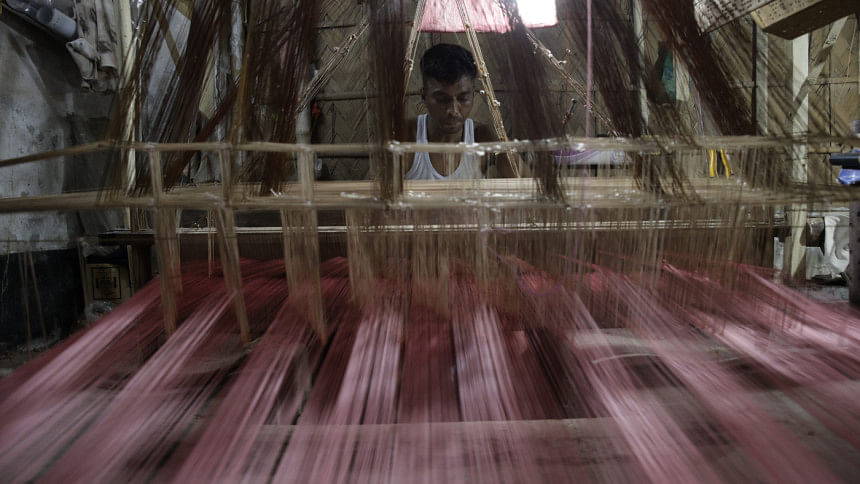
The cost of making a masterpiece
All weavers interviewed spoke of a common adversary: cheap imports from neighbouring countries. Rafiq said it plainly, "They bring sarees from India and sell them, saying they're Bangladeshi. That destroys our industry."
Md Sarwar Ahamad, a taant designer working in the area, added, "The syndicates control the material market. Prices rise there, and we're forced to pay here. We even buy from China now, but with dollar prices rising, it's killing us."
The import channels have created a two-headed crisis: weavers are unable to compete with cheaper products, and they are paying more for the raw materials needed to maintain the quality of their sarees are known for.
"Each Mirpur Katan saree costs around Tk 70,000 to 80,000 to produce. That's the real cost —wages, silk, dyes, labour. If one thread breaks or one mistake is made, you lose hundreds of takas immediately," Ahamad said.
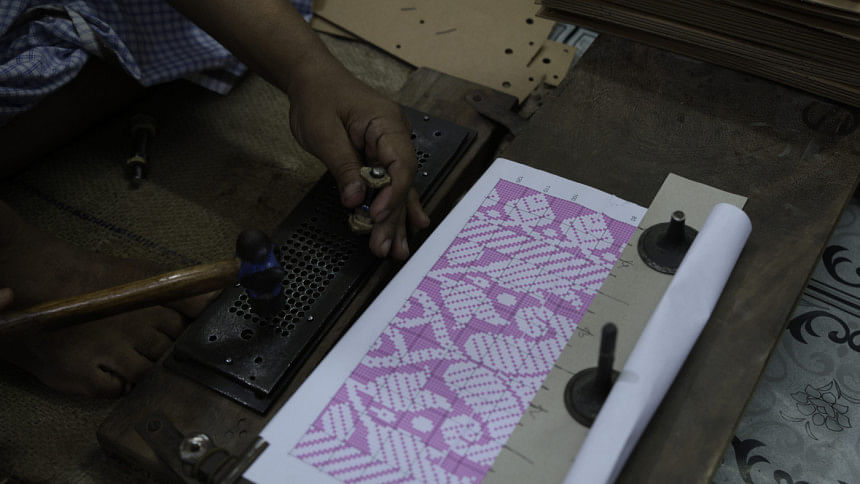
Invisible architects of beauty
Mohammad Nasim, a "Punch Card Master" with 45 years of experience, works silently and precisely. His job is to punch holes into cardboard sheets that control the loom's motion, determining how each motif will appear. He is a living archive of design methodology.
"I still do night shifts to survive," he said. "Then I come and work during the day. All for Tk 200. No one wants to do this after me. There's no training programme, no stipend, no apprentice. If I die tomorrow, the knowledge dies with me."
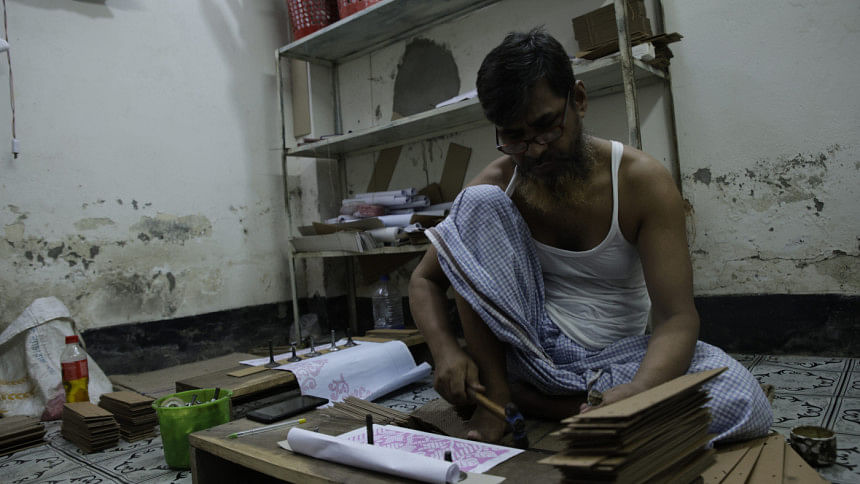
His presence is a reminder that a saree isn't just woven – it's planned, designed, and engineered. Yet, the Punch Card artists are never celebrated. They aren't invited to exhibitions or interviewed by fashion magazines. They are like the footnotes to an award-winning novel — vital, but ignored.
Even designers like Sharmin Rahman agree this is tragic. "Of course, artisans need exposure. However, in this ecosystem, designers get recognition because they create visibility and take risks. For artisans to be seen, the work has to reach the stage first."
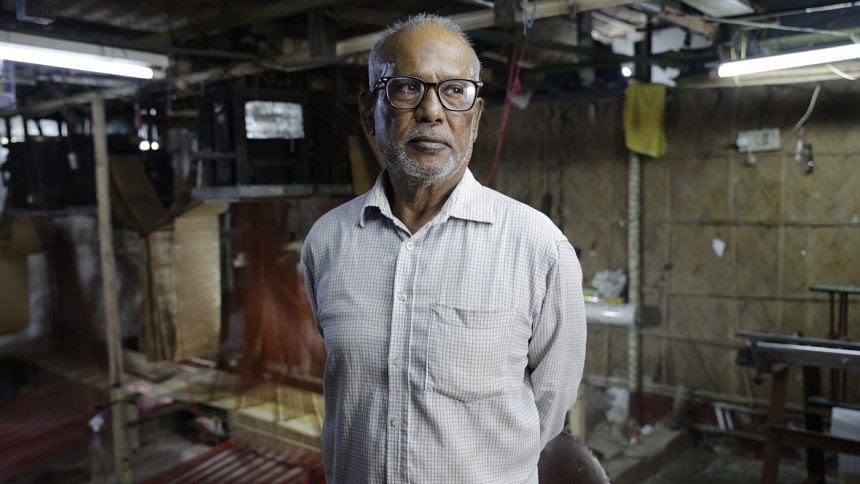
A simple demand: Let us work
Interestingly, none of the weavers ask for donations. "We don't need handouts," said Rafiq. "We just want our sarees to sell at the price they deserve."
What they are asking for is infrastructure, not charity. Rafiq spoke of a vision where dedicated multi-storey buildings could house power looms on one floor, a training centre on another, a showroom on the top, and working spaces for women throughout. "Our women are ready to work. We just need the space."
But his vision did not end with trained weavers or textile graduates. He pointed to a more ignored section of society: the street children.
"There are many street children who get caught up in the wrong things — drugs, petty theft," Rafiq said. "If we could bring them in, teach them this craft, give them a skill, we wouldn't just save the taant industry. We'd be creating employment too. We'd be giving them a future.
In a country where the gap between recognition and redistribution remains wide, this kind of practical thinking from within the community could change more than just an industry — it could shift lives. All it needs is someone to listen.
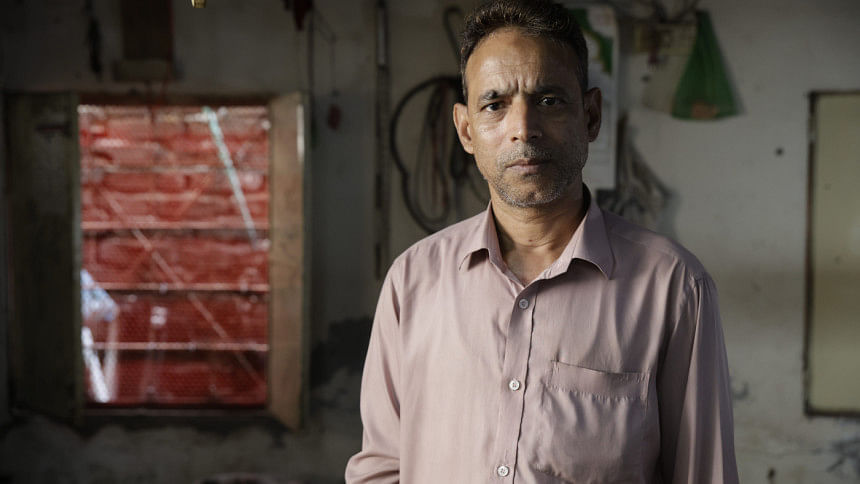
A growing rift
Unlike boutique owners and retailers who simply buy and resell, Ahamad still uses design concepts passed down from Indian masters and refined locally over decades. "But now, many so-called 'designers' don't know what they are doing. They mix Manipuri, Jamdani, and Katan motifs without understanding where one ends and the other begins. It's disrespectful to the craft."
His concern was not just about design dilution, it was also about vanishing collaboration.
"Not a single graduate from any textile institute has come to us yet. They don't visit the loom, don't talk to the weaver. Their knowledge is digital; ours is manual. If these two don't meet, how will the art evolve?"
Sharmin Rahman, a well-known designer who has worked with artisans across Bangladesh, offered a layered explanation when asked why young designers seem to avoid working with traditional weavers.
"People are travelling to Jessore, Rangpur, and even hilly regions to collaborate with artisans, so why not Mirpur, which is right in the heart of Dhaka?" she asked.
"It's not about distance or access. The reality is, working with the weavers in Mirpur is not easy. Most work through middlemen or shopkeepers. It's difficult to locate the artisans directly, and even harder to understand their design language, once you do."
She acknowledged the perception gap from both sides. "Designers want smoother collaboration. But from my own experience, communicating with weavers directly can be complicated — and let's not forget, the shopkeepers aren't eager to make those connections easier either," she elaborated.
Rahman's point raises a deeper question: if collaboration isn't easy, should it be abandoned, or made easier? The weavers believe it's the latter.
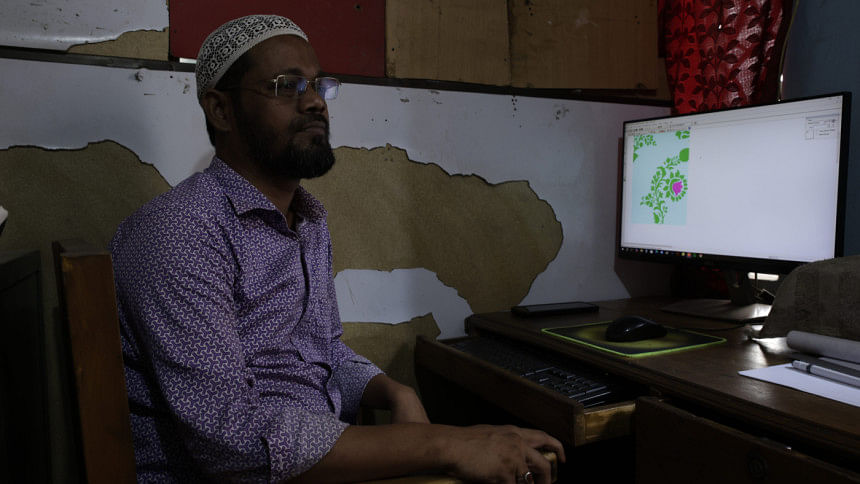
Living with promises: The phantom of Bhashan Char
Md Nizam, another senior weaver who has been with the trade for over three decades, pointed toward a long-unfulfilled promise.
"In the early 2000's, we submitted our names to get land and even gave Tk 10,000 to the government," he recalled. "They said we'd be given plots, maybe in Bhashan Char. But nothing happened. We kept hearing, 'It will happen, it will happen,' and now so many of our people are gone. Who will receive it now?"
His voice trembled — not just from age, but from having to retell this same story year after year. As he sat beneath a collapsed shelf filled with tangled yarn and rusted weaving tools, he expressed what so many artisans feel but few say: "Had we received the proper aid, we would not have had to resort to selling fruits and vegetables."
And while they waited for land, costs soared beyond reach. The resham (silk thread) that once cost them around Tk 1,200 per kilogram now sells for nearly Tk 10,500! That's nearly a tenfold increase in less than two decades. And this is not optional — resham is the heart of the Mirpur Katan. You cannot make these sarees without it. For small weavers already squeezed by falling orders and rising competition from cheap imports, this price hike isn't just painful — it's existential.
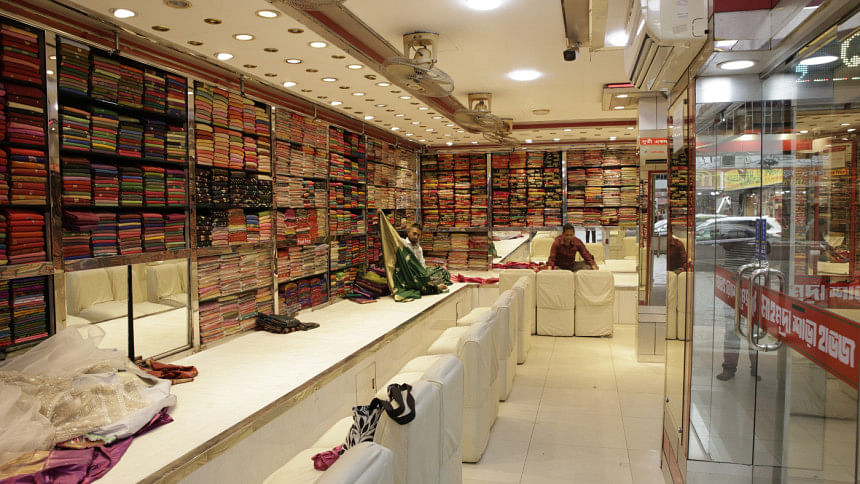
Beyond a certificate
Everyone interviewed agreed on one thing: GI recognition alone means little if nothing changes. Weavers need infrastructure, stable pricing, designer collaboration, and media visibility.
"We love our craft," said Rafiq. "But we don't want to die with it."
Rahman agrees that things need to evolve, but from both sides. "It can't just be about designers coming in and rescuing the craft. The weavers have to meet us halfway, too."
Until that happens, Mirpur Katan will remain a name on paper, not a promise delivered. And the people who made it worth protecting will continue to weave in silence, unheard and unseen.

 For all latest news, follow The Daily Star's Google News channel.
For all latest news, follow The Daily Star's Google News channel. 


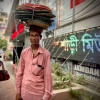





Comments